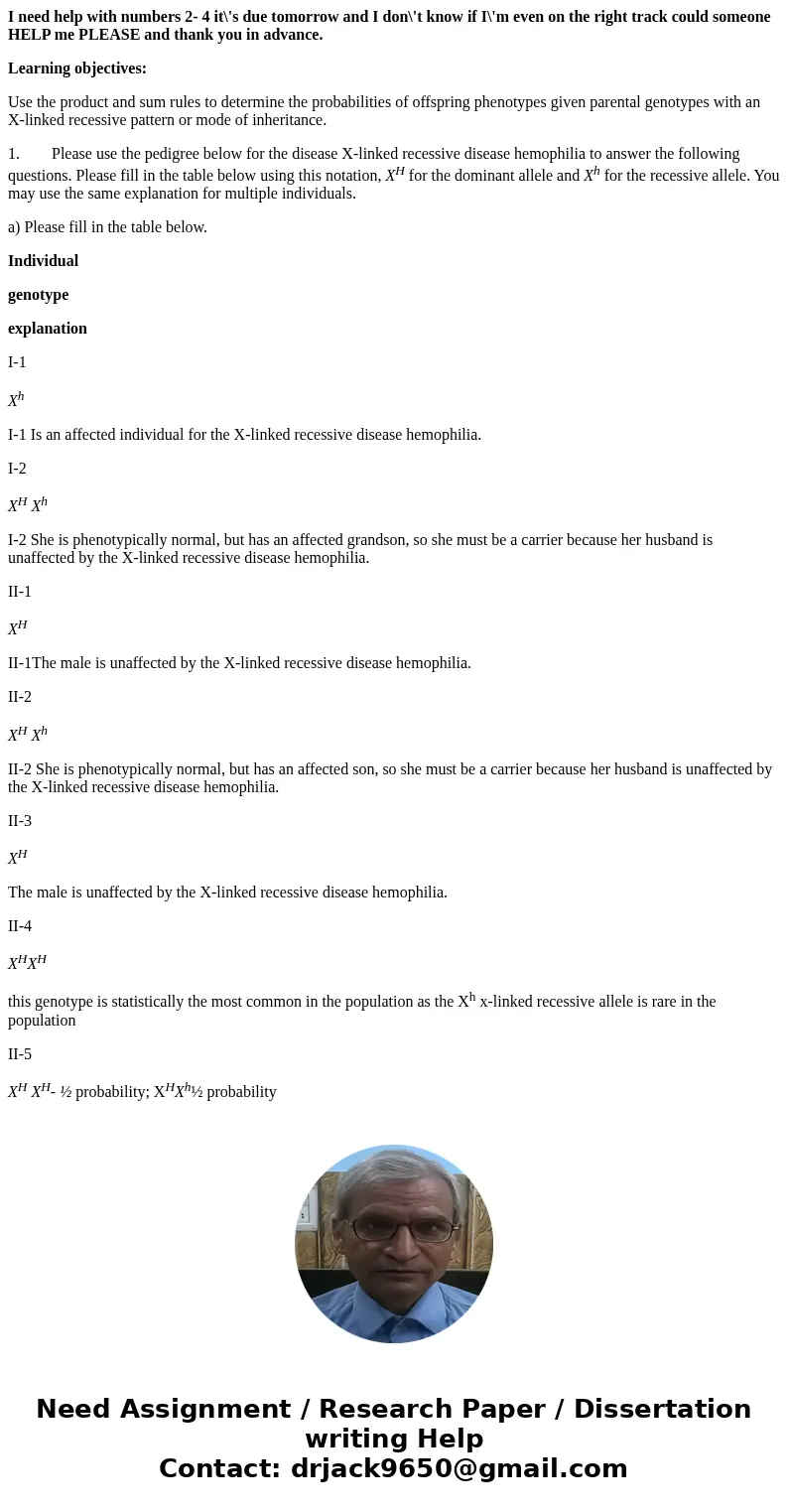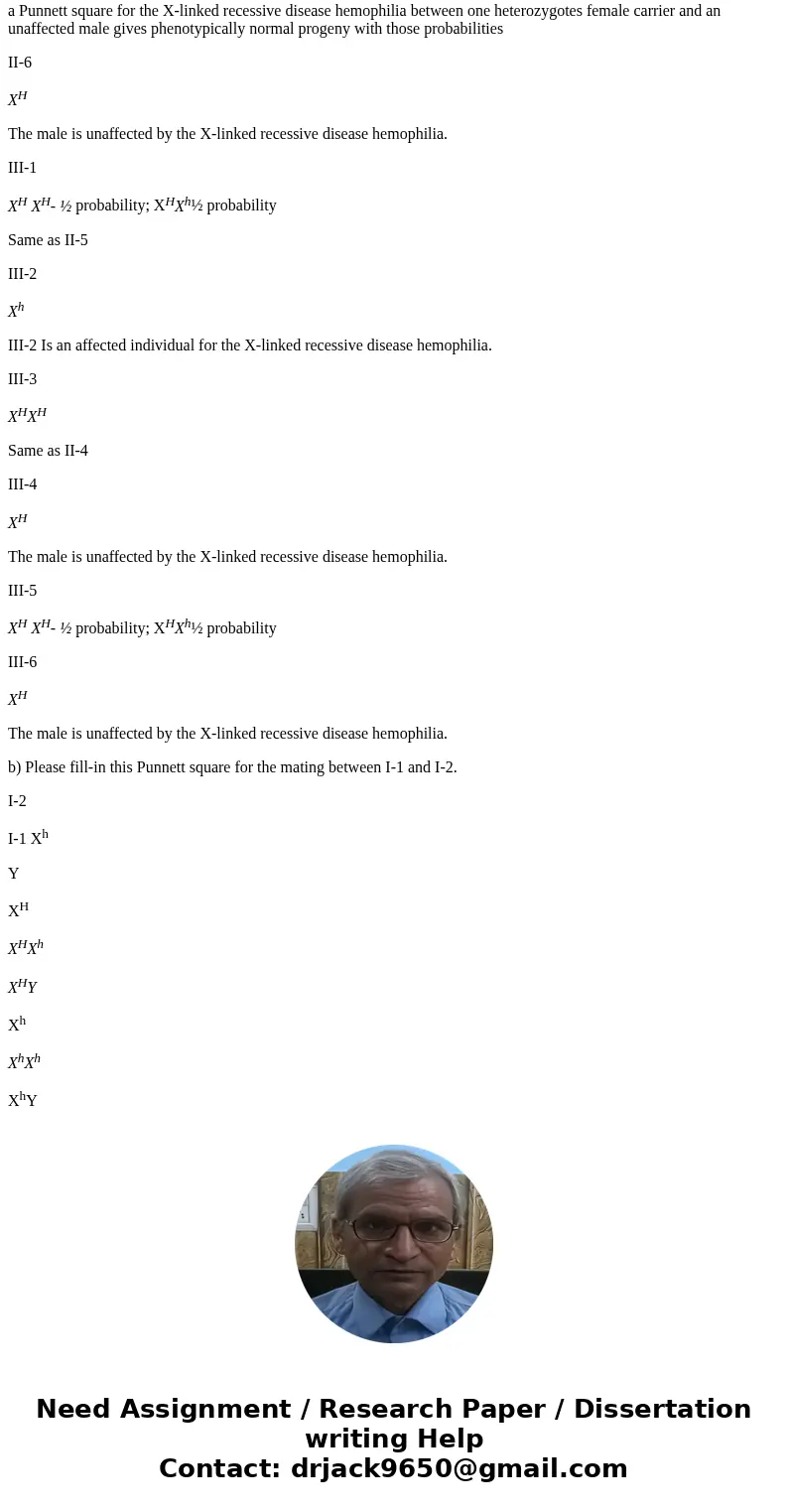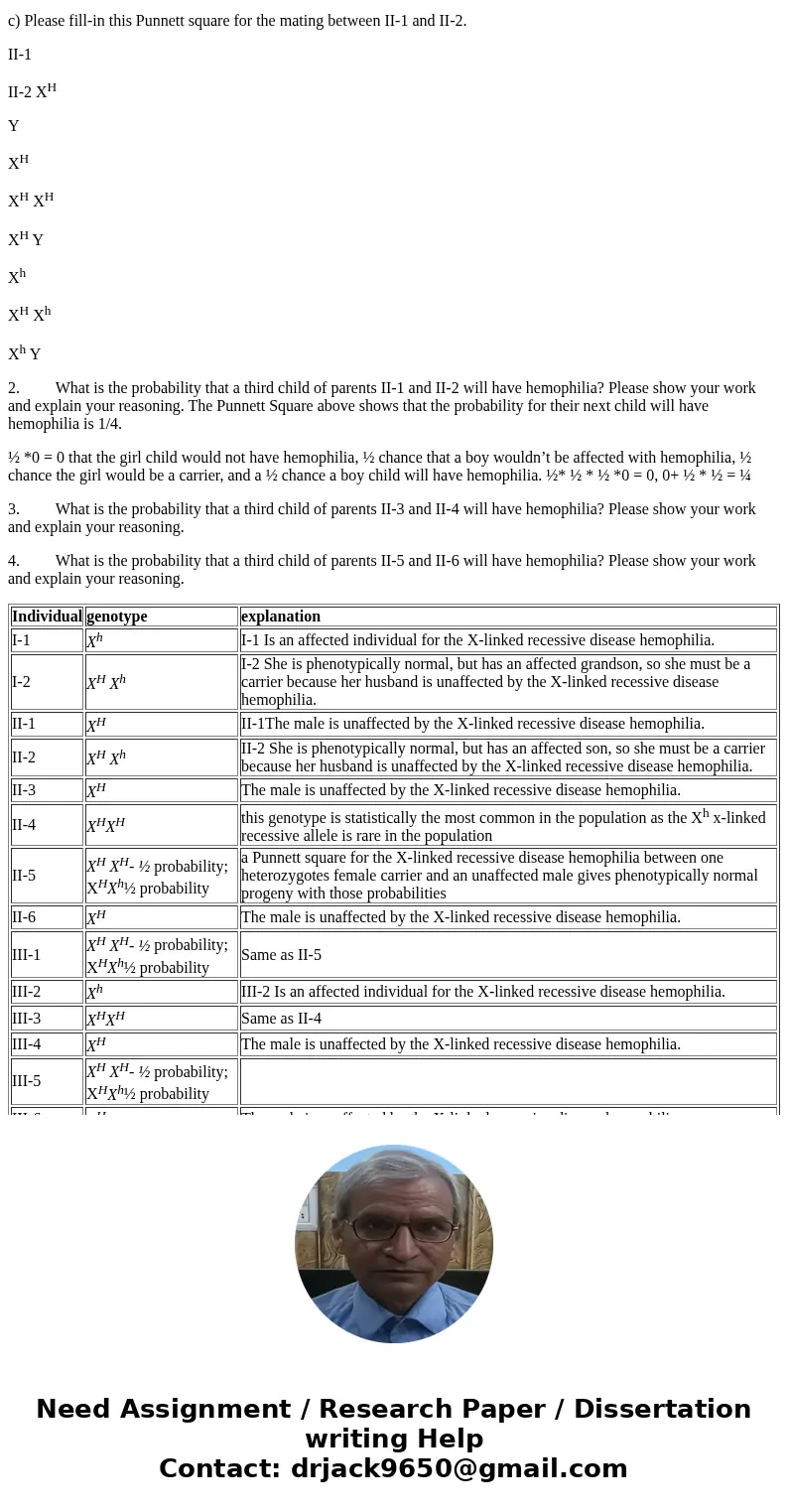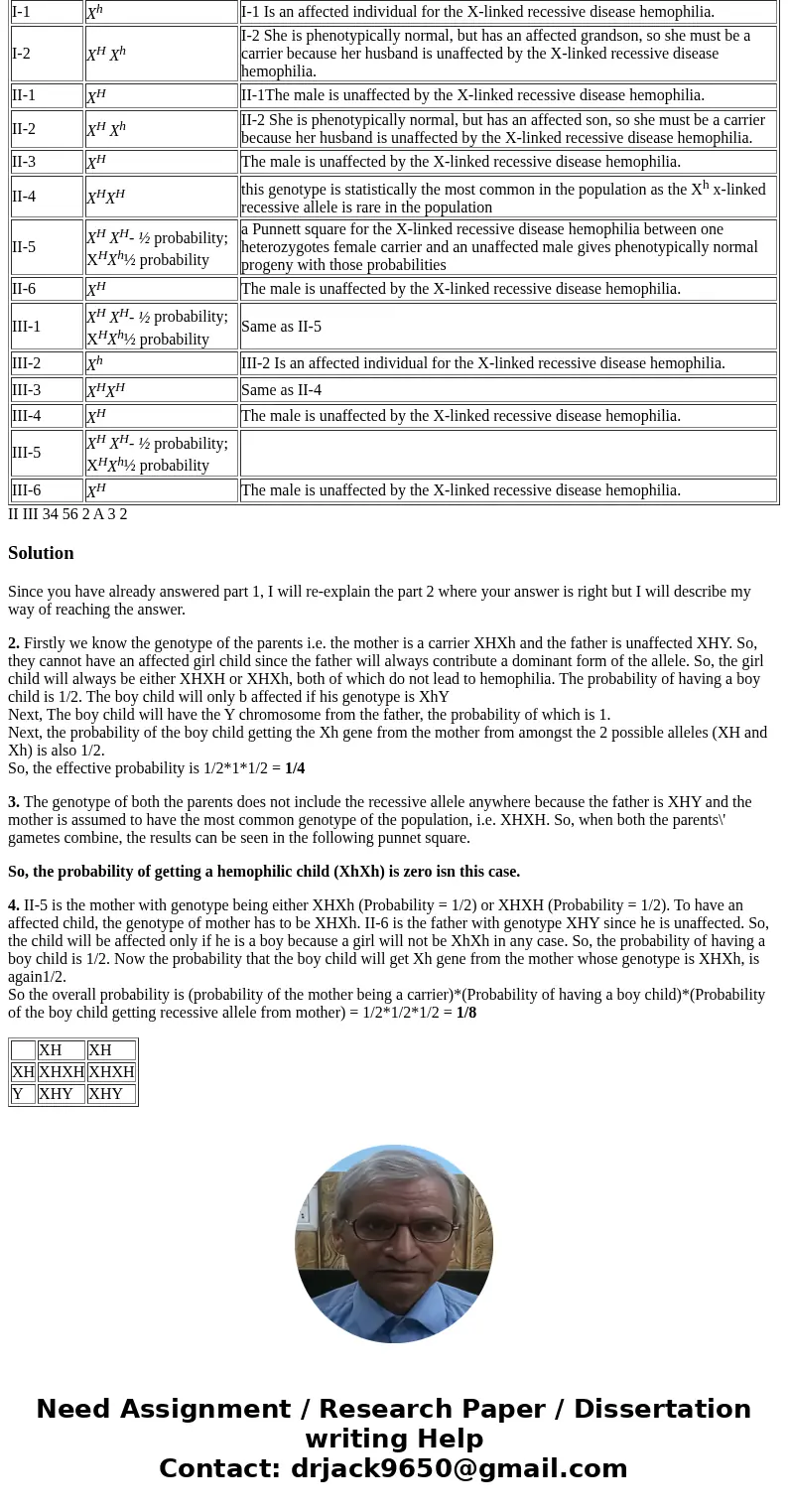I need help with numbers 2 4 its due tomorrow and I dont kno
I need help with numbers 2- 4 it\'s due tomorrow and I don\'t know if I\'m even on the right track could someone HELP me PLEASE and thank you in advance.
Learning objectives:
Use the product and sum rules to determine the probabilities of offspring phenotypes given parental genotypes with an X-linked recessive pattern or mode of inheritance.
1. Please use the pedigree below for the disease X-linked recessive disease hemophilia to answer the following questions. Please fill in the table below using this notation, XH for the dominant allele and Xh for the recessive allele. You may use the same explanation for multiple individuals.
a) Please fill in the table below.
Individual
genotype
explanation
I-1
Xh
I-1 Is an affected individual for the X-linked recessive disease hemophilia.
I-2
XH Xh
I-2 She is phenotypically normal, but has an affected grandson, so she must be a carrier because her husband is unaffected by the X-linked recessive disease hemophilia.
II-1
XH
II-1The male is unaffected by the X-linked recessive disease hemophilia.
II-2
XH Xh
II-2 She is phenotypically normal, but has an affected son, so she must be a carrier because her husband is unaffected by the X-linked recessive disease hemophilia.
II-3
XH
The male is unaffected by the X-linked recessive disease hemophilia.
II-4
XHXH
this genotype is statistically the most common in the population as the Xh x-linked recessive allele is rare in the population
II-5
XH XH- ½ probability; XHXh½ probability
a Punnett square for the X-linked recessive disease hemophilia between one heterozygotes female carrier and an unaffected male gives phenotypically normal progeny with those probabilities
II-6
XH
The male is unaffected by the X-linked recessive disease hemophilia.
III-1
XH XH- ½ probability; XHXh½ probability
Same as II-5
III-2
Xh
III-2 Is an affected individual for the X-linked recessive disease hemophilia.
III-3
XHXH
Same as II-4
III-4
XH
The male is unaffected by the X-linked recessive disease hemophilia.
III-5
XH XH- ½ probability; XHXh½ probability
III-6
XH
The male is unaffected by the X-linked recessive disease hemophilia.
b) Please fill-in this Punnett square for the mating between I-1 and I-2.
I-2
I-1 Xh
Y
XH
XHXh
XHY
Xh
XhXh
XhY
c) Please fill-in this Punnett square for the mating between II-1 and II-2.
II-1
II-2 XH
Y
XH
XH XH
XH Y
Xh
XH Xh
Xh Y
2. What is the probability that a third child of parents II-1 and II-2 will have hemophilia? Please show your work and explain your reasoning. The Punnett Square above shows that the probability for their next child will have hemophilia is 1/4.
½ *0 = 0 that the girl child would not have hemophilia, ½ chance that a boy wouldn’t be affected with hemophilia, ½ chance the girl would be a carrier, and a ½ chance a boy child will have hemophilia. ½* ½ * ½ *0 = 0, 0+ ½ * ½ = ¼
3. What is the probability that a third child of parents II-3 and II-4 will have hemophilia? Please show your work and explain your reasoning.
4. What is the probability that a third child of parents II-5 and II-6 will have hemophilia? Please show your work and explain your reasoning.
| Individual | genotype | explanation |
| I-1 | Xh | I-1 Is an affected individual for the X-linked recessive disease hemophilia. |
| I-2 | XH Xh | I-2 She is phenotypically normal, but has an affected grandson, so she must be a carrier because her husband is unaffected by the X-linked recessive disease hemophilia. |
| II-1 | XH | II-1The male is unaffected by the X-linked recessive disease hemophilia. |
| II-2 | XH Xh | II-2 She is phenotypically normal, but has an affected son, so she must be a carrier because her husband is unaffected by the X-linked recessive disease hemophilia. |
| II-3 | XH | The male is unaffected by the X-linked recessive disease hemophilia. |
| II-4 | XHXH | this genotype is statistically the most common in the population as the Xh x-linked recessive allele is rare in the population |
| II-5 | XH XH- ½ probability; XHXh½ probability | a Punnett square for the X-linked recessive disease hemophilia between one heterozygotes female carrier and an unaffected male gives phenotypically normal progeny with those probabilities |
| II-6 | XH | The male is unaffected by the X-linked recessive disease hemophilia. |
| III-1 | XH XH- ½ probability; XHXh½ probability | Same as II-5 |
| III-2 | Xh | III-2 Is an affected individual for the X-linked recessive disease hemophilia. |
| III-3 | XHXH | Same as II-4 |
| III-4 | XH | The male is unaffected by the X-linked recessive disease hemophilia. |
| III-5 | XH XH- ½ probability; XHXh½ probability | |
| III-6 | XH | The male is unaffected by the X-linked recessive disease hemophilia. |
Solution
Since you have already answered part 1, I will re-explain the part 2 where your answer is right but I will describe my way of reaching the answer.
2. Firstly we know the genotype of the parents i.e. the mother is a carrier XHXh and the father is unaffected XHY. So, they cannot have an affected girl child since the father will always contribute a dominant form of the allele. So, the girl child will always be either XHXH or XHXh, both of which do not lead to hemophilia. The probability of having a boy child is 1/2. The boy child will only b affected if his genotype is XhY
Next, The boy child will have the Y chromosome from the father, the probability of which is 1.
Next, the probability of the boy child getting the Xh gene from the mother from amongst the 2 possible alleles (XH and Xh) is also 1/2.
So, the effective probability is 1/2*1*1/2 = 1/4
3. The genotype of both the parents does not include the recessive allele anywhere because the father is XHY and the mother is assumed to have the most common genotype of the population, i.e. XHXH. So, when both the parents\' gametes combine, the results can be seen in the following punnet square.
So, the probability of getting a hemophilic child (XhXh) is zero isn this case.
4. II-5 is the mother with genotype being either XHXh (Probability = 1/2) or XHXH (Probability = 1/2). To have an affected child, the genotype of mother has to be XHXh. II-6 is the father with genotype XHY since he is unaffected. So, the child will be affected only if he is a boy because a girl will not be XhXh in any case. So, the probability of having a boy child is 1/2. Now the probability that the boy child will get Xh gene from the mother whose genotype is XHXh, is again1/2.
So the overall probability is (probability of the mother being a carrier)*(Probability of having a boy child)*(Probability of the boy child getting recessive allele from mother) = 1/2*1/2*1/2 = 1/8
| XH | XH | |
| XH | XHXH | XHXH |
| Y | XHY | XHY |




 Homework Sourse
Homework Sourse